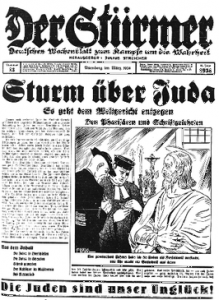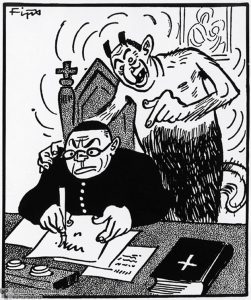Module 3: Religion & Culture
Undermining the Churches and the Nazification of Christianity
As important as it was for the National Socialists to strategically assert continuity between Christianity and Nazi ideology, Hitler and his supporters were critical of existing Protestant and especially Catholic churches.
Undermining the churches worked to Nazify and Aryanize Christianity and the churches and continuously increase animosity towards the Jews. Strategic efforts included stripping Jesus of his Jewishness and repudiating all positive theological understandings of the significance and status of the Jewish people in Christian doctrine.
In the following two examples of Nazi propaganda, the Catholic Church is in league with the devil and all churches are guilty of willfully distorting the essence of Christianity and deceiving the German people.
Left: “Storm above Judah—The world court is coming,” Der Stürmer, March 1934, No. 13. — attacking institutional churches as “Judaized” organizations.
Right: In this propaganda, the Catholic church is presented as being controlled by the Devil. Der Stürmer: The Devil Feeds Anti-NS Slogans to a Catholic Priest. May 1938. Bildarchiv Preußischer Kulturbesitz [the Visual Archive of the Prussian Cultural Heritage Foundation].
The history of the editing out of the Cross in this photo speaks to the shifting, often ambiguous relation between Hitler, the National Socialists and the churches.
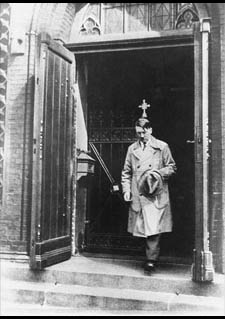
The photograph of Hitler leaving a church. It was published in his book named, Hitler wie ihn keiner kennt [Hitler as nobody knows him] in its first edition with the caption “A photographic chance event becomes a symbol: Adolf Hitler, the supposed ‘heretic’, leaving the Marinekirche in Wilhelmshaven.” In the 1938 edition of the same book the presence of the Cross was edited out of the photograph. The caption was also edited, and the new caption was “Adolf Hitler after sightseeing at the historic Marinekirche in Wilhelmshaven”. Photographer: Heinrich Hoffmann. 1932, leaving the Marinekirche [sic] in Wilhelmshaven.
While there are references of eradicating Christianity in favour of Volkish practice and identity, there was an early effort to replace existing church doctrines with “positive Christianity” and establish a unified Reich Church. While this was ultimately unsuccessful, the Nazification of the churches continued to threaten the independence and authority of the churches throughout the war years.
Nazi Platform, February 24th, 1920: “24. We demand freedom for all religious denominations in the State, provided they do not threaten its existence nor offend the moral feelings of the German race. The Party, as such, stands for positive Christianity, but does not commit itself to any particular denomination. It combats the Jewish-materialist spirit within and without us, and is convinced that our nation can achieve permanent health only from within on the basis of the principle: The common interest before self-interest.
-English translation of the 25-point program.” -German source text as published in Ernst Deuerlein, Der Aufstieg der NSDAP in Augenzeugenberichten, (Munich: Deutscher Taschenbuch Verlag, 1974), 108-12. United States Holocaust Memorial Museum.
The Nazification of Christian practice is represented in these next two images where churches and Christian rituals became the site of Nazi identity and ideology.
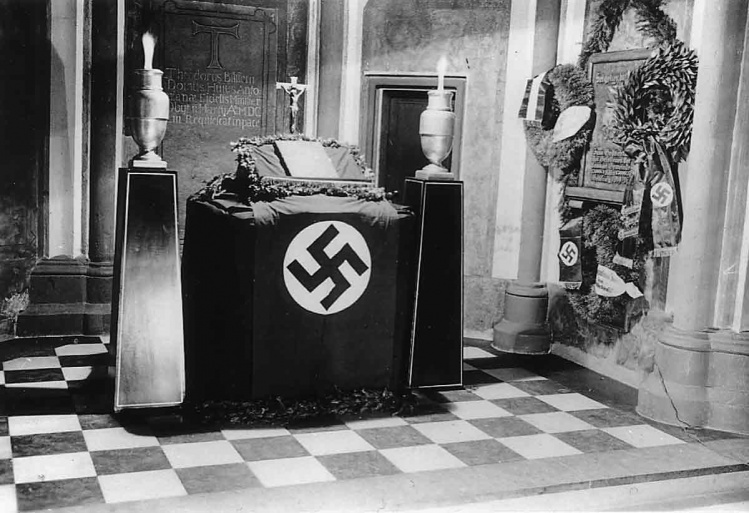
The image above highlights the symbols of the Third Reich, integrating them into the altar of the church. The placement is significant. The altar signifies the leadership and authority of the church and is the place from which the church’s doctrine is taught.
The photograph below is of the baptism of a child born to a Lebensborn member. The Lebensborn was a registered association that was aimed at raising the birthrate of Aryan children born to racially pure and healthy Aryan parents. Here the Christian ritual of baptism, of rebirth in Christianity, is powerfully reframed by the symbols of the Third Reich and the imagery of race, patriotism, militarism and the future of the German people.
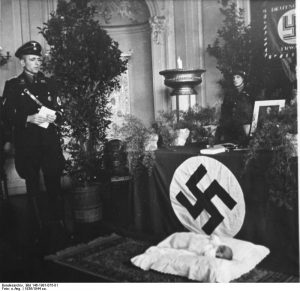
Baptism of a child born to a Lebensborn member. 1936, Germany, photo 4 of 4. Unknown photographer. Bild 146-1981-075-01, German Federal Archive.

